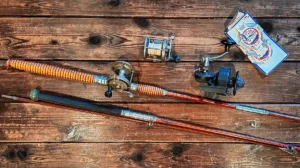Getting as many bites as possible is the goal of every fisherman every time they hit the water. When fishing for enjoyment, getting more bites equals having more fun, and at fishing tournaments, more bites equals more dollars. One way I believe you can maximize the number of bites you get each day is to appeal to all five senses of the bass with your baits. This requires some understanding of how each sense works and how bass use them.
Sight
Bass are primarily sight feeders. This means the main way they locate prey is with their eyes. This tells you how the bass see your bait is most often the key in getting them to strike. This does not mean the bass have to look at your bait for an extended period of time before they will bite. It merely means they will not eat something they have not first seen. Bass can see very well in low light conditions, and they can see colors. The studies I have seen have indicated that bass can detect light about five times better than we can, and they can see the yellow, green and orange spectrums the best.
Hearing and Feeling
These two senses are easiest to talk about when grouped together because they act similar in the water. Both are transmitted through the water by pressure waves. To distinguish between the two, you can think of sound as being any noise your bait will make, and feeling is the water your bait moves. Sound does travel much faster in water than through air, in fact about five times faster, so it does not take long for the noise your bait moves to travel to the fish. Both of these senses become more important as the bass’ ability to see decreases, like in dirty water or heavy cover.
Smell and Taste
These again act very much the same for bass. These senses are mainly close range for bass and are mainly used to compliment feeding behavior. Not much detail is needed in this area for fishermen. Again, both of these senses become much more important as the bass’ ability to see decreases.
A lot of bytes of computer space could be taken up by talking about bass senses, I have just given you a quick and undetailed description of the five senses, but it will give you some idea of how the bass use them to feed. Now how do you use this to your advantage and maximize the amount of bites you get every day.
First analyze what your conditions are. What is the water clarity? What type of cover are you fishing? What are the conditions? You can go on and on from there, but try to establish what you are going to need out of your bait to make the bass bite it. This process is no different than a golfer trying to decide what club to choose to get his ball on the green.
1. Pick a color for the conditions. A rule of thumb to follow is for clear water pick natural looking colors, in dirty water go with bright colors like chartreuse. In clear water you want your bait to look as much like the real thing as possible, while in dirtier water it is more important for your bait to stick out so the bass can find it under conditions of reduced visibility. Dirty water is very much like driving in fog for us, it is harder to see, so we must use our headlights so other drivers can see us.
2. Determine what sound and feel you need. If you are fishing under conditions where a bass’ vision is impaired in some way, whether it is dirty water, heavy cover, or even night fishing, these two senses become more important to the bass. Under such conditions the bass will use these two senses to help them locate their prey. When faced with these conditions I tend to choose baits that are noisier and that displace more water. You can make a bait displace more water in a couple of different ways. One is to make it bigger, two is to give it exaggerated motion (i.e. wider wobble). When not faced with these sorts of conditions, I try to give my baits more of a chance to set the hook.
3. Add quality scent to whatever baits you are throwing. No matter what the conditions, this is something I feel will never hurt your chances of getting a fish to bite. There are plenty of times where a bass may have followed a bait to the boat, and chances are if the bait had been covered with scent that fish may have come up behind it and smelled it. That smell may have enticed him into striking the bait. It will also make the bass hold onto the bait longer, giving you more of a chance to set the hook.
If you choose a bait that will appeal to all five senses of the bass everyday you are on the water, you are going to maximize the number of bites on any given day. You will get a certain number of strikes from fish that have merely seen your bait. You will get a few more strikes from fish that have felt and heard your bait and then saw it and ate it. You will also get a few strikes from fish that have smelled your bait and when they taste it as something natural they will hold on to it longer. So if you can cover all senses, you will get as many strikes as possible.
-Chad Brauer











